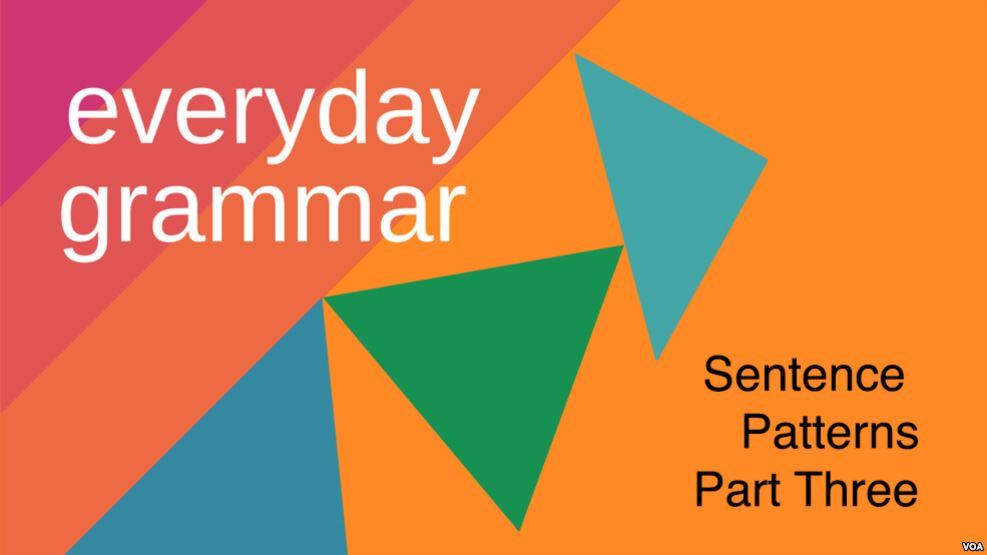
Common Sentence Patterns: Part 3 (8:08)
From VOA Learning English, this is Everyday Grammar.
English has many patterns. Basic grammatical patterns can explain the structure of around 95% of sentences in English, says Martha Kolln, a grammar expert.
Learning and mastering these patterns can help you improve your writing and speaking skills.
We have discussed three common patterns in previous Everyday Grammar stories.
Today we will explore another common pattern: the intransitive verb pattern.
To start you thinking about intransitive verbs consider this passage. It is from the poem “The human family” by famous writer and poet Maya Angelou.
We love and lose in China,
we weep on England’s moors,
and laugh and moan in Guinea,
and thrive on Spanish shores.
By the end of this story, you will be able to recognize and understand the intransitive verb pattern that Angelou uses many times in the stanza.
The intransitive verb pattern:
The intransitive verb pattern is unusual. It is unusual because, unlike other verb patterns, the predicate requires only the verb:
Subject + Intransitive Verb
(Predicate)
Common intransitive verbs include action verbs – go, come, walk, cry, or laugh, for example. In these verbs, the subject’s action is not applied to an object. In other words, most intransitive verbs can end sentences; they do not need nouns or adjectives to their right.*
The lines from the classic American song “Just Friends” give an example of the intransitive verb pattern in its most basic form:
We loved,
we laughed,
we cried
However, sentences with just the subject and intransitive verb are not very common in writing or speaking. Usually, the sentence has more information: an adverbial structure.
Adverbials:
Adverbials are words or phrases that give information about time, place, manner, or reason. Adverbials answer questions like How often? Where? Why? When?
The two most common adverbial structures you will find are adverbs and prepositional phrases.
Adverbs, such as suddenly, quickly, here, soon, or sometimes, modify a verb.
Prepositional phrases are groups of words that begin with a preposition and are followed by an object, usually a noun phrase.
Common prepositions include in, on, at, between, above, and below.
Adverbs and prepositional phrases often follow intransitive verbs.
Think back to the basic intransitive verb pattern.
Subject + Intransitive verb
It is grammatically correct to say a simple sentence like this:
We laughed.
Subject + Intransitive Verb
You can put more information into the sentence by adding an adverb:
We laughed loudly.
Subject + Intransitive Verb + Adverb
Or you could give even more information by adding a prepositional phrase:
We laughed at the man’s silly jokes.
Subject + Intransitive Verb + Prepositional Phrase
In intransitive verb patterns, adverbs or prepositional phrases are often referred to as “optional.” In other words, a sentence is still grammatical without them. You, as the speaker or writer, choose how much information you want to include in the sentence.
What does this have to do with the poem?
Now, think back to the part of Maya Angelou’s poem:
We love and lose in China,
we weep on England’s moors,
and laugh and moan in Guinea,
and thrive on Spanish shores.
You can see that every single line uses an intransitive verb paired with a prepositional phrase.
Consider the first line: We love and lose in China.
The subject is ‘we’ and two intransitive verbs ‘love’ and ‘lose’** are paired with the prepositional phrase, in China. The two verbs are joined by a conjunction, and.

The second line follows the basic intransitive verb pattern, but it has an optional prepositional phrase:

The second two lines follow the same patterns as the first two lines. This series of patterns is an example of parallelism, which you can read about in an earlier Everyday Grammar story.
What can you do?
To practice using the intransitive verb pattern, try writing four lines of poetry in the style of Angelou’s poem. Post your writing in the comments section of this story, or on our Facebook page.
We/I ______ in _______
We/I ______ on _______
And ____ and ____ in/on _____
And _____ on/in ________
Remember, you should not use Angelou’s exact words; rather, you should choose your own noun phrases, intransitive verbs, and prepositional phrases. Just put your own words into the pattern we discussed today.
Learning this pattern, and other patterns discussed in previous grammar stories, will not only help you study the writing of great authors. These patterns will help you write and speak in your own clear, concise sentences, too.
I’m Jill Robbins.
I’m Jonathan Evans.
And I’m John Russell.
John Russell wrote this story for Learning English. Mario Ritter was the editor.
*There are hundreds, if not thousands, of intransitive verbs. As with many grammar rules, there is a small number of exceptions to the intransitive verb pattern. A few intransitive verbs require adverbial information.
** In many contexts, love and lose operate as transitive verbs.
We want to hear from you. Write to us in the Comments Section. _______________________________________________________________
Words in This Story
stanza – n. a group of lines in a poem
pattern – n. something that happens in a regular and repeated way
intransitive – adj. not taking or having a direct object
weep – v. to cry because you are very sad or are feeling some other strong emotion
moor – n. a broad area of open land that is not good for farming — used especially to refer to land in Great Britain — usually plural
moan – v. to make a long, low sound because of pain, unhappiness, or physical pleasure
thrive – v. to grow or develop successfully
